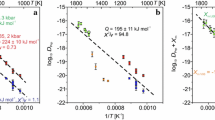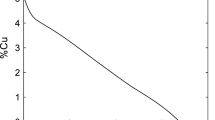Abstract
Stranded elemental or isotopic diffusion profiles in geological materials have the potential to reveal information on the thermal history of the host sample. In the specific case of a concentration step that is established at high temperature, the extent of diffusive relaxation during cooling depends on the details of the cooling path and the Arrhenius diffusion law of the species of interest: In principle, a measured profile in a sample can provide quantitative information on the nature of the cooling path if the diffusion law is known. Using a combination of mathematics and numerical simulations, we derive a simple relationship describing the extent of profile relaxation (as gauged by the slope S 0 of a diffusion profile) as a function of the initial temperature (T i) and cooling rate (\(\dot{T}\)) of the system and the activation energy (E a) and pre-exponential factor (D 0) for diffusion:
The initial temperature T i is expressed in K, \(\dot{T}\) is in °/s, D 0 is in m2/s, and E a is in kJ/mol. The slope of the profile of interest can be estimated either at the midpoint of an interdiffusion profile or at a crystal margin. In the former case, concentrations are normalized to a difference of 100 between the upper (=100) and lower (=0) initial concentration plateaus. For profiles at crystal margins, the normalization range is 0 to 50. The equation above applies equally well to linear and exponential cooling paths because the extent of relaxation indicated by S 0 is essentially the same for a given linear cooling path and an exponential one characterized by the same initial cooling rate. Cooling from the top of parabolic T–t “dome” results in more extensive profile relaxation; this is also well described by the above equation if the leading constant 2.504 is changed to 2.165. If S 0 of a stranded profile has been characterized in the laboratory, and if the Arrhenius law of the diffusant is known, the above equation can be solved uniquely for one of the cooling path parameters (T i or \(\dot{T}\)) if the other—which will usually be T i—is constrained by phase equilibria or the geological context of the sample. Alternatively, if a sample exhibits stranded profiles for two diffusants having different E a and D 0 values, two versions of the above equation can be solved simultaneously for both the initial temperature and the cooling rate. The equation above can be implemented for purposes other than estimating T–t histories: e.g., assessing whether an observed concentration profile is truly the result of diffusion or a consequence of changing phase composition during growth. Our approach also raises the possibility not only of cross-checking multiple laboratory-based diffusion laws but also of estimating Arrhenius parameters for uncharacterized diffusants.










Similar content being viewed by others
References
Ague JJ, Baxter EF (2007) Brief thermal pulses during mountain building recorded by Sr diffusion in apatite and multicomponent diffusion in garnet. Earth Planet Sci Lett 261:500–516
Bindeman IN, Sigmarsson O, Eiler J (2006) Time constraints on the origin of large volume basalts derived from O-isotope and trace element mineral zoning and U-series disequilibria in the Laki and Grímsvötn volcanic system. Earth Planet Sci Lett 245:245–259
Caddick MJ, Konopásek J, Thompson AB (2010) Preservation of garnet growth zoning and the duration of prograde metamorphism. J Petrol 51:2327–2347
Cherniak DJ (1993) Lead diffusion in titanite and preliminary results of the effects of radiation damage on Pb transport. Chem Geol 110:177–194
Cherniak DJ (1995) Sr and Nd diffusion in titanite. Chem Geol 125:219–232
Cherniak DJ (2006) Zirconium diffusion in titanite. Contrib Mineral Petrol 152:639–647
Cherniak DJ (2015) Nb and Ta diffusion in titanite. Chem Geol (in revision)
Cherniak DJ, Watson EB, Wark DA (2007) Ti diffusion in quartz. Chem Geol 236:65–74
Costa F, Chakraborty S (2004) Decadal time gaps between mafic intrusion and silicic eruption obtained from chemical zoning patterns in olivine. Earth Planet Sci Lett 227:517–530
Costa F, Dungan M (2005) Short time scales of magmatic assimilation from diffusion modeling of multiple elements in olivine. Geology 33:837–840
Costa F, Chakraborty S, Dohmen R (2003) Diffusion coupling between trace and major elements and a model for magma residence times using plagioclase. Geochim Cosmochim Acta 67:2189–2200
Costa F, Dohmen R, Chakraborty S (2008) Timescales of magmatic processes from modeling the zoning patterns of crystals. In: Putirka K, Tepley FJ (eds) Minerals, inclusions and volcanic processes. Reviews in Mineralogy and Geochemistry, Mineralogical Society of America. doi:10.2138/rmg.2008.69.14
Crank J (1975) The Mathematics of Diffusion, 2nd edn. Oxford University Press, Oxford
Demouchy S, Jacobsen SD, Gaillard F, Stern CR (2006) Rapid magma ascent recorded by water diffusion profiles in mantle olivine. Geology 34:429–432. doi:10.1130/G22386.1
Devine JR, Rutherford MJ, Norton GE, Young SR (2003) Magma zone storage processes inferred from geochemistry of Fe–Ti oxides in andesitic magma, Soufriere Hills volcano, Montserrat. J Petrol 44:1375–1400
Dohmen R, Kaseman S, Coogan L, Chakraborty S (2010) Diffusion of Li in olivine I: experimental observations and a multispecies diffusion model. Geochim Cosmochim Acta 74:274–292
England PC, Thompson AB (1984) Pressure–temperature–time paths of regional metamorphism I. Heat transfer during the evolution of regions of thickened continental crust. J Petrol 25:894–928
Ganguly J (2010) Cation diffusion in aluminosilicate garnets and geological applications. In: Zhang Y, Cherniak DJ (eds) Diffusion in minerals and melts, Reviews in Mineralogy and Geochemistry 72, Mineralogical Society of America, pp 559–601
Ganguly J, Cheng W, Tirone M (1998a) Cation diffusion in aluminosilicate garnets: experimental determination in pyrope-almandine diffusion couples. Contrib Mineral Petrol 131:171–180
Ganguly J, Tirone M, Hervig RL (1998b) Diffusion kinetics of samarium and neodymium in garnet, and a method for determining the cooling rates of rocks. Science 281:805–807
Ganguly J, Tirone M, Chakraborty S, Domanik K (2013) H-chondrite parent asteroid: a multistage cooling, fragmentation and re-accretion history constrained by thermometric studies, diffusion kinetic modeling and geochronological data. Geochim Cosmochim Acta 105:206–220
Goldstein JI, Yang J, Scott ERD (2014) Determining cooling rates of iron and stony-iron meteorites from measurements of Ni and Co at kamacite–taenite interfaces. Geochim Cosmochim Acta 140:297–320
Griffin WL, Smith D, Ryan CG, O’Reilly SY, Win TT (1996) Trace element zoning in mantle minerals: metasomatism and thermal events in the upper mantle. Can Mineral 34:1179–1193
Ito M, Ganguly J (2006) Diffusion kinetics of Cr in olivine and 53Mn–53Cr thermochronology of early solar system objects. Geochim Cosmochim Acta 70:799–809
Jaoul O, Béjina F (2005) Empirical determination of diffusion coefficients and geospeedometry. Geochim Cosmochim Acta 69:1027–1040
Lasaga AC, Richardson SM, Holland HD (1977) The mathematics of cation diffusion and exchange between silicate minerals during retrograde metamorphism. In: Saxena SK, Bhattachanji S (eds) Energetics of geological processes. Springer, New York, pp 353–388
Liang Y (2010) Multicomponent diffusion in molten silicates: theory, experiments, and geological applications. In: Zhang Y, Cherniak DJ (eds) Diffusion in minerals and melts. Reviews in Mineralogy and Geochemistry 72, Mineralogical Society of America, pp 409–446
Morgan DJ, Blake S (2006) Magmatic residence times of zoned phenocrysts: introduction and application of the binary element diffusion modelling (BEDM) technique. Contrib Mineral Petrol 151:58–70
Morgan DJ, Blake S, Rogers NW, DeVivo B, Rolandi G, Macdonald R, Hawkesworth CJ (2004) Timescales of crystal residence and magma chamber volume from modeling of diffusion profiles in phenocrysts: Vesuvius 1944. Earth Planet Sci Lett 222:933–946
Müller T, Watson EB, Harrison TM (2010) Applications of diffusion data to high-temperature Earth systems. In: Zhang Y, Cherniak D (eds) Diffusion in minerals and melts. Reviews in Mineralogy and Geochemistry, Mineralogical Society of America. doi:10.2138/rmg.2010.72.23
Pan Y, Batiza R (2002) Mid-ocean ridge magma chamber processes: constraints from olivine zonation in lavas from the East Pacific Rise at 9°30′N and 10°30′N. J Geophys Res. doi:10.1029/2001JB000435
Peslier AH, Woodland AB, Wolff JA (2008) Fast kimberlite ascent rates estimated from hydrogen diffusion profiles in xenolithic mantle olivines from southern Africa. Geochim Cosmochim Acta 72:2711–2722. doi:10.1016/j.gca.2008.03.019
Scott ERD, Krot TV, Goldstein JI, Wakita S (2014) Thermal and impact history of the H chondrite parent asteroid during metamorphism: constraints from metallic Fe–Ni. Geochim Cosmochim Acta 136:13–37
Spear FS, Florence F (1992) Thermobarometry in granulites: pitfalls and new approaches. J Precambrian Res. 55:209–241
Tepley FJ III, Davidson JP (2003) Mineral-scale Sr-isotope constraints on magma evolution and chamber dynamics in the Rum layered intrusion, Scotland. Contrib Mineral Petrol 145:628–641
Thomas JB, Watson EB, Spear FS, Shemella PT, Nayak SK, Lanzirotti A (2010) TitaniQ under pressure: the effect of pressure and temperature on Ti-in-quartz solubility. Contrib Mineral Petrol 160:743–759. doi:10.1007/s00410-010-0505-3
Thomas JB, Watson EB, Spear FS, Wark DA (2015) TitaniQ recrystallized: experimental confirmation of the original Ti-in-quartz calibrations. Contrib Mineral Petrol 169:27. doi:10.1007/s00410-015-1120-0
Tissot BP, Pelet R, Ungerer P (1987) Thermal history of sedimentary basins, maturation indexes, and kinetics of oil and gas generation. AAPG Bull 71:1445–1466
Wark DA, Watson EB (2006) TitaniQ: a titanium-in-quartz geothermometer. Contrib Mineral Petrol 152:743–754. doi:10.1007/s00410-006-0132-3081
Watson EB, Harrison TM (1984) Accessory minerals and the geochemical evolution of crustal magmatic systems: a summary and prospectus of experimental approaches. Phys Earth Planet Inter 35:19–30
Weibe RA, Wark DA, Hawkins DP (2007) Insight from cathodoluminescence zoning into crystallization of the Vinalhaven granite, coastal Maine. Contrib Mineral Petrol 154:439–453
Wilson CR, Smith D (1985) A numerical study of mineral zoning formed during the cooling of finite volume grains. J Geophys Res 90:10351–10358
Zellmer GF, Sparks RSJ, Hawkesworth CJ, Wiedenbeck M (2003) Magma emplacement and remobilization timescales beneath Montserrat: insights from Sr and Ba zonation in plagioclase phenocrysts. J Petrol 44:1413–1431
Zhang Y (2008) Geochemical Kinetics. Princeton University Press, Princeton
Zhang Y, Cherniak DJ (2010) Diffusion in Minerals and Melts. Reviews in Mineralogy and Geochemistry v. 72. In: Zhang Y, Cherniak DJ (eds) Mineralogical Society of America, Chantilly
Acknowledgments
This work was supported by NSF Grants EAR-0948204 to E. B. Watson and EAR-0738734 to D. J. Cherniak. Michael AckersonDustin Trail and Youxue Zhang provided helpful comments on a draft of the manuscript. Official reviews by Yan Liang and Ralf Dohmen were insightful and valuable.
Author information
Authors and Affiliations
Corresponding author
Additional information
Communicated by Mark Ghiorso.
Electronic supplementary material
Below is the link to the electronic supplementary material.
Rights and permissions
About this article
Cite this article
Watson, E.B., Cherniak, D.J. Quantitative cooling histories from stranded diffusion profiles. Contrib Mineral Petrol 169, 57 (2015). https://doi.org/10.1007/s00410-015-1153-4
Received:
Accepted:
Published:
DOI: https://doi.org/10.1007/s00410-015-1153-4




